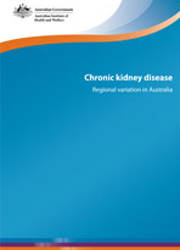Summary
Chronic kidney disease (CKD) is a common and serious problem in Australia and its management can be resource intensive. Those with CKD's most severe form, end-stage kidney disease (ESKD), usually require kidney replacement therapy (KRT) to survive, either in the form of dialysis or kidney transplantation.
As with other chronic conditions, the prevalence and incidence of CKD varies by where people live. This report provides a detailed picture of how CKD varies in Australia according to geographic location. Differences are explored in the incidence, prevalence, treatment, hospitalisations, deaths and the effect of Indigenous status on CKD and ESKD. This report also examines the relocation of patients when undergoing treatment for ESKD.
The mortality rate for CKD-related deaths was higher in Remote and very remote areas than in other regions
In 2010, the age-standardised rate of deaths with an underlying cause of CKD was considerably higher in more remote areas than in urban areas for both males and females. For males the death rate was 19 deaths per 100,000 population in Remote and very remote areas, compared to 13 deaths per 100,000 in Major cities. For females the comparable figures were 29 and 10 deaths per 100,000 population.
Remote and Very remote areas have higher rates of new cases of treated-ESKD than other areas
In 2008–10, the rate of new cases of treated-ESKD was highest in Remote and Very remote areas (19 and 44 cases per 100,000 population respectively, compared to 10 per 100,000 population in Major cities).
Hospitalisations rates for regular dialysis in Remote and very remote areas were higher than other areas
In 2010–11, hospitalisation rates for regular dialysis for people in Remote and very remote areas were at least twice the rates in other areas.
Aboriginal and Torres Strait Islander people are more likely than other Australians to be hospitalised with CKD
In 2010–11, across all remoteness categories, the Indigenous age-standardised rate for regular dialysis hospitalisations was at least 7 times the rate for other Australians. This difference increased substantially in Outer regional and Remote and very remote areas.
Incompleteness of Indigenous identification means that the number of hospitalisations, treated-ESKD cases, and deaths recorded are likely to underestimate the true level of morbidity and mortality in Aboriginal and Torres Strait Islander people.
Preliminary material: Acknowledgments; Abbreviations; Introduction
1 Chronic kidney disease
2 Incidence of ESKD
3 Prevalence and type of treatment for ESKD
4 Movement for treatment
5 Aboriginal and Torres Strait Islanders with CKD by remoteness
Appendixes
Appendix A: Supplementary tables
Appendix B: Methods
End matter: Glossary; References; List of tables; List of figures



